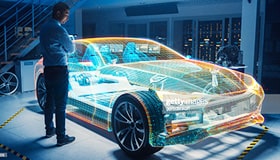EV charging and renewable energy for sustainable transportation
The adoption of Electric Vehicles (EVs) improves air quality and helps reduce greenhouse gas emissions. Such adoption, however, needs a reliable and convenient charging infrastructure, including smart EV charging. Renewable energy sources (RESs), such as solar photovoltaics (PV) and wind energy systems, can fill these infrastructural gaps and help to decarbonise the environment. RESs can also help reduce PV ownership costs by providing low-cost electricity.
Wind power and PV are variable energy sources, making it challenging to power electric cars with renewable energy. To overcome this difficulty, wind and solar installations must be sized to ensure sufficient energy, even during minimal sunshine and wind periods. This approach guarantees adequate energy generation and storage for charging electric cars, even when renewable energy generation is low. Such an approach also significantly reduces their carbon footprint.
Renewable-based charging stations can be of two types: grid-connected and standalone. An additional storage system is essential for providing a continuous power supply in a standalone system. The transmission system is vital in always ensuring the balance between consumption and production.
Charging from wind energy
Wind energy is a renewable energy source that can charge EVs without depleting natural resources. The wind farms are located distant from electric vehicle charging facilities, and the electricity generated by wind turbines is transmitted long distances to charging stations through the power grid. Wind turbines do not produce greenhouse gas emissions or air pollutants.
A wind turbine is typically rated in the order of megawatts, whilst an EV charger usually works in kilowatts. A single wind turbine can charge several hundred cars.
Some of the challenges associated with using wind energy EV charging are:
- Wind turbines generate electricity only when there is sufficient wind, which can vary throughout the day and from season to season. Wind generation is maximum in winter and in the night time. Hence, wind generation is ideally suited for charging electric cars at home at night.
- Excess wind energy produced during periods of high wind needs to be stored in energy storage devices and delivered during periods with less wind. The intermittency of wind energy requires energy storage systems to ensure reliable and continuous EV charging services.
Renewable energy sources such as solar and wind can be unreliable due to their irregular output. To ensure a consistent power supply, combining multiple energy sources is recommended. Solar panels and wind turbines are easy to integrate and ideal. Figure 1 shows a horizontal axis wind turbine with a permanent magnet synchronous generator (PMSG) and uncontrolled diode bridge rectifier. The Wind Energy Conversion System (WECS) needs to operate at variable speeds to be effective.

Figure 1: Wind Energy Conversion System (WECS)
The wind energy field commonly uses MPPT methods to maximise power output in wind turbines. These methods adjust the generator speed to track the maximum power point of the turbine. The most popular methods include Tip-speed ratio (TSR), Perturb and Observe (P&O), power signal feedback, and Fuzzy Logic Control.
The TSR algorithm adjusts the generator speed to achieve the optimal tip-speed ratio, maximising the wind turbine's power output. The P&O algorithm is effective for all turbine types because of its simplicity and efficiency. It adjusts the generator speed based on the difference between measured power output and a reference value without requiring knowledge of turbine characteristics or operating conditions.
The optimal MPPT method may vary based on the turbine design and operating conditions. Therefore, a thorough analysis is recommended before selecting a control strategy.
Charging from solar energy
Electric vehicles may be charged using solar energy, which is cost-effective and environmentally friendly. Solar panels can be installed on rooftops or on the ground to generate electricity from the sun, and the energy can be stored in batteries or directly used to charge electric vehicles. By combining electric vehicles with solar energy, we can create a sustainable and efficient transportation system that benefits both the environment and our economy.
One of the advantages of solar panels is their ease of installation on rooftops, making it possible to generate solar power close to where electric vehicles will be charged. This reduces transmission losses and improves efficiency. Rooftop solar PV systems are typically rated in kilowatts, similar to the power rating of an EV charger. Unlike wind generation, solar generation is highest during the day and in the summer. This makes solar generation ideal for charging electric cars at workplaces during the day when energy demand is high. By utilising solar power for EV charging, we can reduce our reliance on fossil fuels, lower carbon emissions, and decrease our impact on the environment.
The power and current curves of a solar panel with respect to voltage are nonlinear. The nonlinear nature of solar panels shows the requirement for using the MPPT algorithm. The maximum power occurs at different voltage values for changing irradiance. Several popular algorithms, such as P&O, Incremental Conductance (IC), and MPPT using fuzzy logic, are used in solar photovoltaic systems. The IC method is particularly effective in swiftly varying solar radiation conditions. This method uses a search strategy to adjust the converter duty ratio, causing the solar panel voltage to change and search for the maximum power point. The search ends once the desired point is reached. The IC method effectively maximises power output and ensures the efficient operation of solar photovoltaic systems, especially in rapidly changing environmental conditions.

Figure 2: Solar-powered EV charging station
To create a solar-powered EV charging station, a solar inverter is the simplest method, a DC-to-DC power converter operates the solar panels at the maximum power point, and a DC-AC inverter converts the DC power to 50Hz or 60Hz AC power for AC charging of the EV. However, this method could be more efficient as it converts DC power to AC and back again. A more efficient approach is using an isolated DC-to-DC converter to charge the EV from PV using DC charging directly. As shown in figure-2 10kW solar-powered charger, this method includes a DC-to-DC converter for the solar panels, an isolated DC-DC converter for the EV, and a DC-to-AC inverter to connect to the AC grid. This method also allows the EV battery to be used as storage for renewable energy.
Stay informed
Keep up to date on the latest information and exclusive offers!
Subscribe now
Thanks for subscribing
Well done! You are now part of an elite group who receive the latest info on products, technologies and applications straight to your inbox.
Related Article
- Charging protocols and safety standards for EV Charging Infrastructures
- The Future of EV Infrastructure: Navigating trends, opportunities, and benefits
- A Developer's Guide for designing the EV Charging using the right tool
- Revolutionizing Electric Vehicles - Innovations in Motor Control Systems
- How to implement Smart Metering in EV charging
- How to design an efficient power conversion circuit for EV Chargers
- Transforming Mobility: The Architecture and Solutions of V2X Communication in Electric Vehicles
- The effects of electric vehicle charging stations to the power grid
- Cyber security of public charging stations
- Powering Up with Safety and Ease: The Art of EV Charger Design
- EV Charging Standards: Ensuring Compatibility and Safety in the Charging Process
- EV charging and renewable energy for sustainable transportation
- EV Charging and Battery Management System
- Wireless Power Transfer: A Convenient and Efficient Solution for EV Charging
- Design Considerations for High-Efficiency EV Chargers
- The benefits and challenges of electric vehicles
- Communication network for electric vehicle charging
- How to boost Level-3 EV charging with the right connectivity
- How SPI isolated communication helps BMS in EVs








